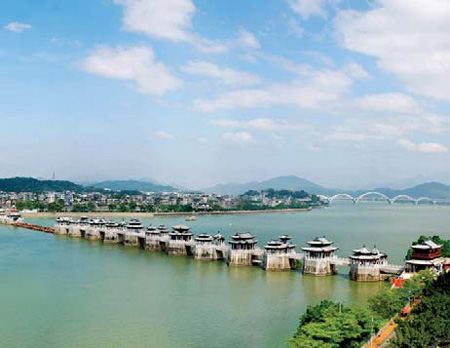Cradle of 'Chao culture' uses its history and local flavor for international fame
|
Guangji Bridge, built about 800 years ago, is one of the world's earliest examples of a bridge that can open to let large boats pass. Provided to China Daily |
With its rich cultural heritage, traditional industries, and ocean resources, Chaozhou is on its way to becoming a modern coastal city, one that is conducive to business, sightseeing, and general living.
Its idea for the 12th Five-Year Plan (2011-2015) is to develop itself into a historical, cultural city that is known nationwide or even worldwide, to become a base for special industries, and to be a center for Guangdong province's harbor-using industries.
Chaozhou is the province's easternmost city, with the South China Sea to the southeast, and Fujian province to the east. It includes the Xiangqiao and Fengxi districts and has Chao'an and Raoping counties under its jurisdiction.
Its harbor is a natural deepwater harbor, only 192 nautical miles (about 356 km) from Hong Kong, and 186 nautical miles from the port city of Kaohsiung, Taiwan. So, it is Guangdong's nearest city to Taiwan and is right in the middle of the golden Hong Kong, Kaohsiung, Xiamen (Fujian) maritime zone.
Chaozhou is commonly referred to as the cradle of "Chao Culture", which has its own dialect. It also has its own music, opera, cuisine, tea, and 12 items on the nation's cultural heritage list.
These include wood carvings, embroidery, Dawu village's clay sculptures, and Jinshi township's puppet drama.
The Guangji Bridge and Imperial Son-in-law Xu's Mansion are well worth visiting, as are the following:
Huang Jilue Temple, often is referred to as "a wood carving museum";
Kaiyuan Temple, a Buddhist temple built more than 1,200 years ago and referred to as "eastern Guangdong's No 1 Temple";
the Han Yu Memorial, one of the oldest memorials to honor Huan Yu, a man of letters (AD 768-824) who was deported to Chaozhou, in 819, during the Tang Dynasty (AD 618-907);
the 500-year-old Daoyun Building, which was built in the eight-trigram battle arrangement, one of China's biggest Hakka earthen buildings and a masterpiece among the city's 700 earthen building complexes;
Memorial Arch Street of Taiping Road, recognized as "China's No 1 Street", with its many memorial arches.
Chaozhou has more than 50,000 private businesses, large and small, and its traditional industries - porcelain, garments, foodstuffs, electronics, stainless steel, plastics, packaging, and printing - have all seen rapid development in recent years. The city's ceramic exports date as far back as the late Tang Dynasty and it is now the nation's largest ceramic-product manufacturing and exporting base. It was given the title of "China's china capital" in 2004.
One thing related to this business that is worth mentioning is that all the tableware for State banquets at the 2008 Beijing Olympics opening ceremonies was from Chaozhou.
The city's wedding and evening dresses, and its equipment for aquatic use have also found a market niche both at home and abroad.
(China Daily 02/17/2011 page7)





















